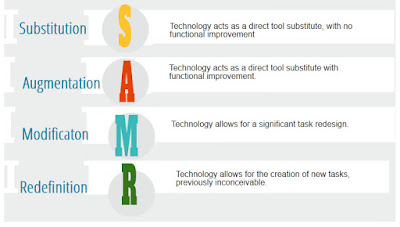Google recently made Voice Typing available for schools (Google Apps for Education accounts).
There are several ways that this can be used in with students.
It's not just replacing (Substituting, see SAMR) pencil and paper or even typing.
I believe that there are some substantive, educational benefits to this feature that could really be a game-changer for many students that haven't been reached by other methods or tools. For these students, this could be Augmentation or even Modification.

1. In the Tools menu of Google Docs, you'll now see "Voice Typing".


2. You'll then see a little window on the left with a microphone icon in it. Do as it says: "Click to speak".
3. When you're speaking (and therefore typing), you'll see this red microphone icon.

There are several ways that this can be used in with students.
It's not just replacing (Substituting, see SAMR) pencil and paper or even typing.
I believe that there are some substantive, educational benefits to this feature that could really be a game-changer for many students that haven't been reached by other methods or tools. For these students, this could be Augmentation or even Modification.

There's not much to say about how to use it, but for those that may not be familiar, here's how it works:
1. In the Tools menu of Google Docs, you'll now see "Voice Typing".


2. You'll then see a little window on the left with a microphone icon in it. Do as it says: "Click to speak".
3. When you're speaking (and therefore typing), you'll see this red microphone icon.

Now for the educational benefits....
The Speaking and Listening standards in the CCSS can be addressed:
1. The quiet ones
I find that every year, I have several students that struggle with speaking loudly enough to be heard when speaking to the whole room.
2. Those that don't enunciate well enough to be understood
Others don't have a volume problem, but an enunciation problem.
This tool could give both of those kind of students practice working on their speaking.
The Writing standards are now (more) accessible for all students.
Many students have issues that prevent them from participating in anything beyond the earliest stages of the writing process:
3. Those with fine motor skills issues
Holding a pencil, or even typing, is a physical issue that makes the academic thinking of revising, improving, or correcting their written work nearly out of reach.
4. Those with profound difficulty with spelling
They can at least get their ideas out, and think about sentence structure, and deeper tasks such as revising and improving their work.
5. Those with more extensive needs for speech therapy
Depending on the accuracy of this tool, it might even help students realize, "Oh, that's what that sounds like when I say ____". Some students don't realize how they sound unless we record their voice and play it back to them. This tool could certainly play a part of helping those students.
It may now be possible for all students to excel even more with the Writing standards, and the Language standards
6. Those that struggle with focus (ADD-type issues)
Doodling, manipulating the paper, excessive erasing, etc.
I have witnessed how helpful voice typing is when using an iPad with a student with just these issues. Now even more students can access this solution to those struggles.
7. More writing, more thinking, more creating
If writing and typing take significantly less time, then even students without special needs or struggles can write more, think more, and create more, since this tool can speed up a rather mundane, time-consuming part of the process.
The naysayers...
There are certainly those that will respond with things like:"But in the real world, they're still going to need to type."
"Yeah, but they still need to know how to write with a pencil."
or other similar criticisms.
My response is this:
How long are we going to protect a barrier for these students to do higher order thinking?
What's the point of continuing a prerequisite that prevents students from language-rich conversations about their own word choice, manipulating complex sentences?
Let's let them at least get their ideas out, on the digital page, so they can do some deeper, more critical thinking about their own work!
This is 2015. These types of tools and features are not going to go away. They're going to be more common, not less. They are going to get more and more ubiquitous. We might as well acknowledge that, as we grapple with tools that are just becoming available now.
Sure, they're going to have to use a pencil and a keyboard at some point. Must we wait until these overcome all their barriers before we allow them to learn the other parts of the writing process?
After all, we must prepare them for their future, not our past.
I very much welcome your thoughts. How else can you see this tool benefiting students? How else can we use it in the classroom? Please leave a comment!



